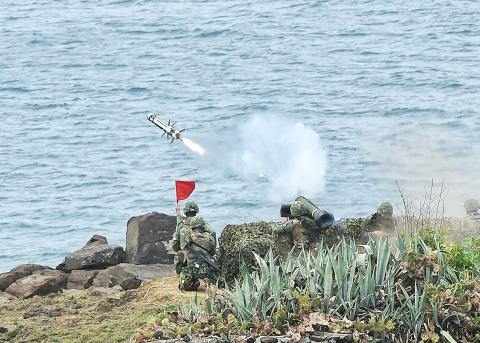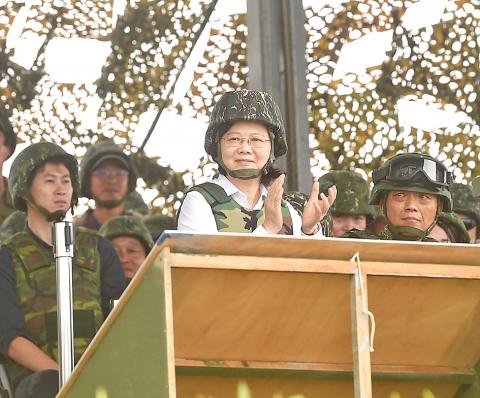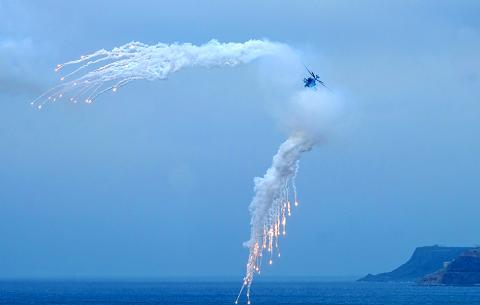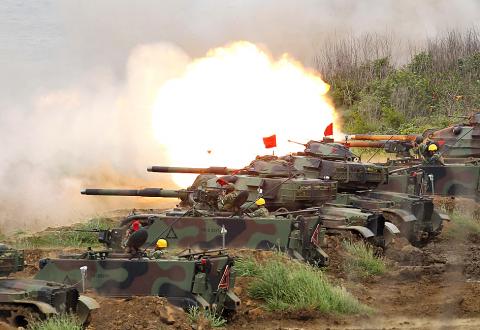The armed forces yesterday conducted a live-fire exercise in the Penghu islands, concluding the main part of the 33rd annual Han Kuang military exercises, with President Tsai Ing-wen (蔡英文) observing the drill which simulated a landing attempt by China’s People’s Liberation Army (PLA).
The scenario involved a landing by the PLA, with the nation’s armed forces launching an operation to repel the attack.
The Marine Corps acting as PLA troops launched an amphibious assault, with a naval formation of Keelung-class destroyers, a Tuo Chiang-class stealth corvette and Kuang Hua VI fast-attack missile boats providing covering fire.

Photo: Fang Pin-chao, Taipei Times
The air force then launched the first wave of counterattack, with a group of fighter jets firing missiles at target areas at sea, and the army mobilized attack helicopters, tanks and infantry units, and launched an artillery barrage against landing troops.
More than 3,900 soldiers, sailors, airmen and marines participated in the exercise, and weapons and equipment used in the drill included F-16 jets, Indigenous Defense Fighters, AH-64E Apache helicopters, UH-60M Blackhawk helicopters, CH-47 Chinook transport helicopters, RT-2000 multiple launch rocket systems, M60A3 tanks, 155mm and 105mm howitzers, and other light weapons.
Tsai praised the performance of the armed forces, saying the drill was necessary to ensure national safety and the well-being of Taiwanese.

Photo: Fang Pin-chao, Taipei Times
The president reiterated her pledge to build the nation’s defense capabilities with locally developed weapons, including submarines, surface vessels and trainer jets.
The government would raise the nation’s research and manufacturing capabilities to develop necessary weapons, which could boost the local defense sector and the business environment as a whole, Tsai said.
“The most important thing in achieving defensive self-sufficiency is to show the world that Taiwan is determined to defend itself,” Tsai said.

Photo: AFP/Sam Yeh
“As the commander-in-chief, I am the most reliable supporter of the armed forces. The government will fully support the military in either reforming national defense or improving the working conditions for military personnel,” she said.
Yesterday was the fourth day of this year’s Han Kuang exercises, the first such event since the Ministry of National Defense changed the nation’s defense strategy from “effective deterrence” to “multi-layered deterrence.”
Although the content shared with the media showed a traditional live-fire drill, there were electronic warfare operations involved, suggesting the military’s awareness to adapt to changes in battle strategies and tactics, Ministry of National Defense spokesman Major General Chen Chung-chi (陳中吉) said.

Photo: AP/Chiang Ying-ying
Today is the last day of this year’s drill, simulating a Chinese attack on the Ching Chuan Kang (清泉崗) air base in Taichung.
The response to the simulated attack is to involve all branches of the armed forces, including fighter jets and surface-to-air missiles.

The CIA has a message for Chinese government officials worried about their place in Chinese President Xi Jinping’s (習近平) government: Come work with us. The agency released two Mandarin-language videos on social media on Thursday inviting disgruntled officials to contact the CIA. The recruitment videos posted on YouTube and X racked up more than 5 million views combined in their first day. The outreach comes as CIA Director John Ratcliffe has vowed to boost the agency’s use of intelligence from human sources and its focus on China, which has recently targeted US officials with its own espionage operations. The videos are “aimed at

STEADFAST FRIEND: The bills encourage increased Taiwan-US engagement and address China’s distortion of UN Resolution 2758 to isolate Taiwan internationally The Presidential Office yesterday thanked the US House of Representatives for unanimously passing two Taiwan-related bills highlighting its solid support for Taiwan’s democracy and global participation, and for deepening bilateral relations. One of the bills, the Taiwan Assurance Implementation Act, requires the US Department of State to periodically review its guidelines for engagement with Taiwan, and report to the US Congress on the guidelines and plans to lift self-imposed limitations on US-Taiwan engagement. The other bill is the Taiwan International Solidarity Act, which clarifies that UN Resolution 2758 does not address the issue of the representation of Taiwan or its people in

US Indo-Pacific Commander Admiral Samuel Paparo on Friday expressed concern over the rate at which China is diversifying its military exercises, the Financial Times (FT) reported on Saturday. “The rates of change on the depth and breadth of their exercises is the one non-linear effect that I’ve seen in the last year that wakes me up at night or keeps me up at night,” Paparo was quoted by FT as saying while attending the annual Sedona Forum at the McCain Institute in Arizona. Paparo also expressed concern over the speed with which China was expanding its military. While the US

SHIFT: Taiwan’s better-than-expected first-quarter GDP and signs of weakness in the US have driven global capital back to emerging markets, the central bank head said The central bank yesterday blamed market speculation for the steep rise in the local currency, and urged exporters and financial institutions to stay calm and stop panic sell-offs to avoid hurting their own profitability. The nation’s top monetary policymaker said that it would step in, if necessary, to maintain order and stability in the foreign exchange market. The remarks came as the NT dollar yesterday closed up NT$0.919 to NT$30.145 against the US dollar in Taipei trading, after rising as high as NT$29.59 in intraday trading. The local currency has surged 5.85 percent against the greenback over the past two sessions, central